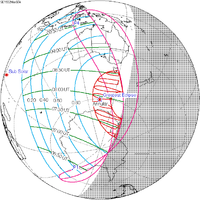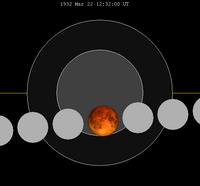|
March 1932 lunar eclipse
A partial lunar eclipse occurred at the Moon’s descending node of orbit on Tuesday, March 22, 1932,[1] with an umbral magnitude of 0.9666. A lunar eclipse occurs when the Moon moves into the Earth's shadow, causing the Moon to be darkened. A partial lunar eclipse occurs when one part of the Moon is in the Earth's umbra, while the other part is in the Earth's penumbra. Unlike a solar eclipse, which can only be viewed from a relatively small area of the world, a lunar eclipse may be viewed from anywhere on the night side of Earth. Occurring only about 21 hours before perigee (on March 23, 1932, at 9:10 UTC), the Moon's apparent diameter was larger.[2] This was the last of the first set of partial lunar eclipses in Lunar Saros 131, preceding the first total eclipse on April 2, 1950. VisibilityThe eclipse was completely visible over northeast Asia, Australia, and northwestern North America, seen rising over much of Asia and setting over much of North America and western South America.[3]
Eclipse detailsShown below is a table displaying details about this particular solar eclipse. It describes various parameters pertaining to this eclipse.[4]
Eclipse seasonThis eclipse is part of an eclipse season, a period, roughly every six months, when eclipses occur. Only two (or occasionally three) eclipse seasons occur each year, and each season lasts about 35 days and repeats just short of six months (173 days) later; thus two full eclipse seasons always occur each year. Either two or three eclipses happen each eclipse season. In the sequence below, each eclipse is separated by a fortnight.
Related eclipsesEclipses in 1932
Metonic
Tzolkinex
Half-Saros
Tritos
Lunar Saros 131
Inex
Triad
Lunar eclipses of 1930–1933This eclipse is a member of a semester series. An eclipse in a semester series of lunar eclipses repeats approximately every 177 days and 4 hours (a semester) at alternating nodes of the Moon's orbit.[5] The penumbral lunar eclipses on February 10, 1933 and August 5, 1933 occur in the next lunar year eclipse set.
Saros 131This eclipse is a part of Saros series 131, repeating every 18 years, 11 days, and containing 72 events. The series started with a penumbral lunar eclipse on May 10, 1427. It contains partial eclipses from July 25, 1553 through March 22, 1932; total eclipses from April 2, 1950 through September 3, 2202; and a second set of partial eclipses from September 13, 2220 through April 9, 2563. The series ends at member 72 as a penumbral eclipse on July 7, 2707. The longest duration of totality will be produced by member 38 at 100 minutes, 36 seconds on June 28, 2094. All eclipses in this series occur at the Moon’s descending node of orbit.[6]
Eclipses are tabulated in three columns; every third eclipse in the same column is one exeligmos apart, so they all cast shadows over approximately the same parts of the Earth.
Half-Saros cycleA lunar eclipse will be preceded and followed by solar eclipses by 9 years and 5.5 days (a half saros).[8] This lunar eclipse is related to two total solar eclipses of Solar Saros 138.
See alsoNotes
External links
|
|||||||||||||||||||||||||||||||||||||||||||||||||||||||||||||||||||||||||||||||||||||||||||||||||||||||||||||||||||||||||||||||||||||||||||||||||||||||||||||||||||||||||||||||||||||||||||||||||||||||||||||||||||||||||||||||||||||||||||||||||||||||||||||||||||||||||||||||||||||||||||||||||||














































